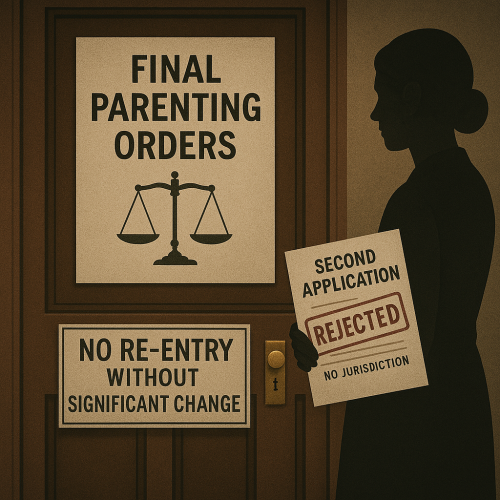FLAST is a network and community focused on Family Law in Australia and providing support and training for members with current family law matters.
Access the FLAST-AI Legal Research Assistant
FLAST helps improve access to justice for it's members with:
Free Daily Court Digests of Cases Coming out of the Family Courts.
Private Members area where members can communicate with legal professionals, ask questions, engage in discussions all with an anonymous profile.
Mentoring Services to help guide you through the quagmire that is Family Law working collaboratively with your lawyers.
Document Drafting Services with review by Legal Practitioners.
Case Management Services with review by Legal Practitioners.
Ad-Hoc legal services for advice when you need it, keeping costs down.
AN OVERVIEW OF THE FLAST NETWORK
Join FLAST as a subscribed member for added services.
CLICK HERE TO JOIN or UPGRADE Membership
CLICK HERE TO JOIN or UPGRADE Membership
Click Below to Book a Free Consultation
In Kesselman & Brimble [2025], the Federal Circuit and Family Court of Australia (Division 1) tackled a high-conflict parenting dispute involving children with significant behavioural needs and a mother living with PTSD. At the core of the dispute was the issue of parental responsibility: should it be shared, or should the mother—who alleged coercive and violent behaviour from the father—have sole authority over major decisions? Justice Boyle’s detailed judgment offers a nuanced and trauma-informed approach to family violence, shared parenting, and the realities of co-parenting in complex circumstances.
📋 Facts and Issues:
🧾 Facts:
- The parties have two children: X (9) and Y (7), both diagnosed with ADHD, Oppositional Defiant Disorder (ODD), and emotional dysregulation.
- The mother alleged the father engaged in physical, emotional, financial, and sexual abuse, which she detailed in affidavits and supported with psychological and therapeutic evidence.
- The mother was diagnosed with PTSD and treated by Dr O, who confirmed the negative impact of any contact with the father on her functioning.
- The father denied abuse but acknowledged some poor behaviour and had undertaken multiple parenting and family violence courses.
- The father sought equal shared parental responsibility, eventual equal time with the children, and the appointment of a parenting coordinator.
- The mother sought sole parental responsibility, structured time arrangements, and communication restrictions.
❓ Issues:
- Did the father perpetrate family violence against the mother?
- Should the mother have sole parental responsibility or should decision-making be shared?
- What parenting time arrangements would best serve the children’s safety and development?
- Should the parties be ordered to communicate through a parenting coordinator or platform?
- What considerations apply in high-conflict parenting cases involving trauma?
⚖️ Application of Law to Facts:
🔹 Family Violence Findings:
- The Court applied the evidence-based risk assessment approach from Isles & Nelissen (2022) FLC 94-042 and M v M (1988) 166 CLR 69.
- Justice Boyle accepted the mother’s allegations of family violence (including sexual assault, coercive control, and financial abuse) based on:
- Consistency of her testimony.
- Corroborating psychological evidence from Dr O and Ms G.
- Historical documents such as family violence reports and counselling records ([70]).
- The Court held that the mother had been subjected to conduct that “made her fearful and was coercive and controlling” ([70]).
🔹 Parental Responsibility:
- Under s 61D(3) and s 60CC of the Family Law Act 1975 (Cth), the Court assessed the best interests of the children.
- Despite the father's engagement in parenting courses and therapy, he remained unable to participate in timely and effective decision-making, especially regarding:
- Y’s surgery ([114]).
- Medical appointments ([89]–[93]).
- School enrolment planning ([102]–[104]).
- The mother was found to be the consistent and reliable decision-maker, proactive in managing the children’s complex needs.
- Requiring her to consult the father would aggravate her PTSD and compromise her parenting capacity ([125]).
- The Court granted the mother sole parental responsibility and decision-making authority ([127]).
🔹 Time and Living Arrangements:
- The Court ordered that the children live with the mother and spend four nights per fortnight with the father.
- Equal time or more extended holiday blocks were rejected due to the children’s difficulty with transitions and the impact on their emotional regulation ([76]–[83]).
- This arrangement balanced the children’s expressed desires with their developmental and psychological needs.
🔹 Communication and Parenting Coordination:
- The father sought use of email/text and a parenting coordinator.
- The Court rejected both:
- Parenting coordination would be expensive, ineffective, and trigger the mother’s trauma ([137]).
- Email/text lacked the boundaries and structure needed to protect the mother’s mental health ([145]).
- The Court ordered the use of “Our Family Wizard”, a secure parenting app ([146]).
🧠 Judgment Analysis and Reasoning:
Justice Boyle’s judgment reflects:
- A trauma-informed, child-focused approach.
- Strong deference to expert psychological and therapeutic evidence (Dr O, Ms G, and Ms R).
- A refusal to allow aspirational or speculative parenting plans to interfere with current well-being ([78]–[79]).
- Recognition of how family violence and PTSD impair effective co-parenting ([93], [125]).
- Respect for the children’s rights to stability, predictable routines, and a safe emotional environment.
The judgment prioritised practical safety and functionality over formal parental symmetry.
📚 Cited Authorities:
- Family Law Act 1975 (Cth) – ss 60CA, 60CC, 61D, 65DAA
- Isles & Nelissen (2022) FLC 94-042 – risk assessment framework
- M v M (1988) 166 CLR 69 – assessing future risk of harm
- Pickford & Pickford [2024] FedCFamC1A 249 – features of coercive control
- Rice & Asplund (1979) FLC 90-725 – change in circumstances (referenced indirectly)
🎓 Take-Home Lesson:
In complex parenting disputes involving family violence and PTSD, the Court will prioritise the children's safety and the mental health of the primary carer over equal time or shared decision-making ideals. Practical realities, trauma impact, and expert evidence will often override theoretical co-parenting models, especially where one parent poses a continued emotional risk.
In Re: Morgan, the Federal Circuit and Family Court was asked to determine whether a 16-year-old transgender girl, Morgan, was Gillick competent to consent to Stage 2 gender-affirming hormone therapy, despite her father's religious objections. The judgment of Anderson J addresses pressing issues at the intersection of family law, gender identity, medical ethics, and children's rights. The Court’s ruling underscores the primacy of a child’s best interests and autonomy in such deeply personal decisions.
📋 Facts and Issues:
🧾 Facts:
- Morgan, born in 2008, identifies as female and has been receiving Stage 1 treatment (puberty blockers) since 2019.
- The mother sought orders confirming Morgan's capacity to consent to Stage 2 treatment (oestrogen therapy) and a change of name.
- The father opposed the application on religious grounds, initially disputing Morgan’s diagnosis and capacity.
- Medical professionals confirmed Morgan's diagnosis of Gender Dysphoria and assessed her as Gillick competent.
- Morgan had been under suicidal distress due to delays in treatment and lack of paternal support.
- Final parenting orders from 2018 granted shared parental responsibility, but the father had not been involved in Morgan’s care since 2019.
❓ Issues:
- Does Morgan meet the criteria for Gender Dysphoria as defined in DSM-5?
- Is Morgan Gillick competent to consent to Stage 2 gender-affirming treatment?
- Is Stage 2 treatment in Morgan’s best interests?
- Should the 2018 final parenting orders be discharged or varied?
- Should the mother have sole parental responsibility?
- Should Morgan’s name change be legally recognised?
⚖️ Application of Law:
🔹 Gender Dysphoria Diagnosis:
The Court relied on DSM-5 diagnostic criteria and the uncontested expert reports of Dr B and Dr D, who had treated Morgan since 2019. The father ultimately conceded the diagnosis during closing submissions ([40]–[49], [56]).
🔹 Gillick Competence:
The Court applied the test from Gillick v West Norfolk and Secretary, Department of Health v J.W.B. and S.M.B. (Marion’s Case):
A child can consent to medical treatment if they have sufficient maturity and intelligence to understand its nature and consequences ([25], [57]–[63]).
Morgan had clearly articulated her understanding of treatment risks, alternatives, fertility implications, and long-term consequences. The father, by the end, conceded Morgan’s competence, although the Court stated it would have found her competent regardless ([58]–[61]).
🔹 Best Interests and Stage 2 Treatment:
Under s 60CA and s 60CC of the Family Law Act 1975, the Court concluded treatment was necessary for Morgan’s welfare:
- Without Stage 2 treatment, Morgan faced serious mental health risks, including suicide ([65]–[73]).
- Experts testified that further delay would damage both her physical health (due to bone loss from blockers) and emotional well-being ([66]–[72]).
🔹 Parenting Orders and s 65DAAA:
Despite previous final orders, the Court found a significant change in circumstances, including:
- Total breakdown of father-daughter relationship.
- Father’s non-involvement since 2019.
- Morgan’s complex health needs solely managed by the mother ([78]–[82]).
The father consented to the variation, satisfying the criteria under s 65DAAA(3) ([34], [78]).
🔹 Sole Parental Responsibility:
Given the father's lack of involvement and opposition grounded solely in religious belief, the Court awarded sole parental responsibility to the mother ([85]).
🔹 Change of Name:
The Court found the change consistent with Morgan’s identity and best interests, further enabled by the mother’s sole parental responsibility ([86]–[88]).
🧠 Judgment Analysis and Reasoning:
Justice Anderson delivered a thorough and empathetic decision, emphasizing:
- The clinical consensus on Gender Dysphoria and Morgan’s understanding of treatment risks.
- The irrelevance of religious objections when determining a child’s medical best interests.
- The need to resolve the case urgently, given Morgan’s suicidality and distress caused by delays ([10], [71], [77]).
- The contributions of a supportive parent and the importance of therapeutic relationships in health outcomes ([91]).
The Court applied Re: Kelvin and Re: Jamie, confirming that where there is parental disagreement, the Court must determine Gillick competence and best interests ([19]–[26]).
📚 Key Authorities Cited:
- Gillick v West Norfolk and Wisbech Area Health Authority [1986] AC 112
- Secretary, Department of Health v J.W.B. and S.M.B (1992) 175 CLR 218 ("Marion’s Case")
- Re: Kelvin (2017) 57 Fam LR 503
- Re: Jamie (2013) 50 Fam LR 369
- Rice & Asplund (1979) 6 Fam LR 570 – on reconsidering final orders
- Chapman v Palmer (1978) 4 Fam LR 462 – name change principles
- Bell v Tavistock [2021] EWCA Civ 1363 – competency in gender-affirming treatment
🎓 Take-Home Lesson:
The Family Court will uphold a mature minor’s right to self-determination when supported by expert evidence, even against parental religious objections. The child’s welfare remains paramount. Legal objections to gender-affirming treatment must be grounded in evidence, not ideology.
📘 Introduction:
In Abramsson & Abramsson (No 3), the Family Court was confronted with a procedural challenge following final parenting orders. The mother, having launched an appeal against those orders, filed a further application seeking not only a stay but also an interim reversal of the children’s living arrangements. Justice Carew’s brief but decisive judgment focused squarely on the question of jurisdiction, highlighting the procedural missteps litigants must avoid post-final orders.
📋 Facts and Issues:
🧾 Facts:
- Final parenting orders were made on 6 December 2024, granting the father sole parental responsibility and residence of the children.
- The mother appealed the decision and sought a stay of the final orders on 20 December 2024, along with interim orders seeking to reverse the children’s living arrangements.
- The stay application was dismissed on 29 January 2025.
- Despite the dismissal, the mother's application for interim parenting orders continued.
- The father filed his own stay application, set for hearing before the original trial judge.
- The Court dismissed the remainder of the mother’s application for lack of jurisdiction.
❓ Issues:
- Does the Court have jurisdiction to entertain an application for interim parenting orders after final orders have been made and while an appeal is on foot?
- Is the mother entitled to a reversal of parenting arrangements through her existing application?
- Should costs be awarded against the mother?
⚖️ Application of Law:
🔹 Jurisdiction and Final Orders:
Justice Carew emphasized that once final parenting orders are made, interim orders cannot be issued unless:
- A new Initiating Application is filed; and
- The applicant satisfies s 65DAAA of the Family Law Act 1975 (Cth), which requires a significant change in circumstances to justify reopening parenting proceedings ([6]).
Since the mother had neither filed a new initiating application nor demonstrated any change in circumstances, her application was outside the Court’s jurisdiction.
🔹 Appeal and Procedure:
- The appeal proceedings are separate from the original parenting proceedings ([6]).
- A stay application must be heard by the original trial judge, which in this case was Justice Baumann ([8]).
🔹 Costs:
- The Court awarded costs of $321 to the father, as the mother was entirely unsuccessful, and the only relevant costs were those incurred at the hearing ([9]–[10]).
🧠 Judgment Analysis and Reasoning:
Justice Carew’s reasoning hinged on procedural integrity and judicial economy:
- Jurisdiction was clearly lacking: Without a fresh initiating application and proof of a material change in circumstances post-final orders, the Court had no authority to make interim orders ([6]).
- The mother’s procedural approach was flawed, seeking to re-argue the living arrangements outside the proper legal avenue.
- The judgment also clarified that appellate and original parenting proceedings are legally distinct, preventing re-litigation under the guise of interim relief ([6]).
- The Judge took a measured approach to costs, awarding only those relevant to the unnecessary hearing.
📚 Cited Legislation and Authority:
- Family Law Act 1975 (Cth), s 65DAAA – Requirement of significant change in circumstances for initiating new parenting proceedings after final orders.
- No additional cases were directly cited due to the brevity and procedural nature of the ruling.
🎓 Take-Home Lesson:
Procedural correctness is paramount in post-final order parenting disputes. Once final orders are made, attempts to alter them through interim applications—without establishing a significant change or following proper procedures—are likely to fail. Litigants must respect jurisdictional limits and seek variation only through valid, legally recognised avenues.
Introduction:
The case of Morcos & Lindon (No 3) demonstrates the complexities that arise when family law intersects with estate disputes, trust structures, and alleged fraud. Justice Bennett was tasked with adjudicating post-final-order applications, including requests for joinder, substitution, a stay pending appeal, and clarifications under the slip rule. The judgment sheds light on the fine line between legitimate litigation steps and attempts to re-litigate substantive issues after finality.
Facts and Issues:
Facts:
- Mr. Morcos (husband) and Ms. Lindon (wife) were parties in property settlement proceedings.
- The key property at D Street, Suburb E, was legally in the name of the husband’s late mother (Ms B), but found to be beneficially owned by the husband.
- After final orders were made on 20 January 2025, the husband attempted to:
- Resign as Executor and install his daughters as Trustees.
- Apply to have these Trustees substituted or joined to the proceedings.
- Obtain a stay of final orders pending appeal.
- Seek various amendments under the slip rule, notably concerning CGT liabilities and a misidentified caveat.
- The wife sought corrections to ensure clarity and accuracy in execution of the orders.
Issues:
- Can the daughters (Trustees) be joined or substituted in the proceedings?
- Should the Court grant a stay of the final property orders pending appeal?
- Do the identified errors qualify for correction under the slip rule?
- Was there legal justification to adjust for CGT without supporting evidence?
- Should costs be reserved or awarded?
Application of Law:
1. Substitution/Joinder:
- The Court referred to s 92 of the Family Law Act 1975.
- Justice Bennett declined to substitute or join the Trustees as the application was inappropriate post-judgment and better suited to be dealt with on appeal (see [29]–[30]).
2. Stay of Orders:
- The Court adopted the principles from Jackson & Balen [2009] FamCAFC 131 at [28], citing foundational cases:
- Federal Commissioner of Taxation v Myer Emporium Ltd
- Alexander v Cambridge Credit Corporation Ltd
- The stay was granted based on the arguable merit of the appeal and potential prejudice if the property were sold prematurely ([41]–[42]).
3. Slip Rule Applications:
- Governed by Rule 10.13 of the FCFCA Rules 2021 (Cth).
- The Court referenced Harrell & Nesland [2020] FamCAFC 21 and Gould v Vaggelas [1985] 157 CLR 215.
- The following amendments were allowed:
- Correction of caveat details ([47]–[51]).
- Clarity regarding the formula for proceeds distribution ([61]–[67]).
- Rejected amendments included:
- CGT considerations ([80]–[81]).
- Superannuation adjustments and property sales administration changes ([60], [82]–[83]).
Analysis of Judgment:
Justice Bennett’s reasoning was meticulous, balancing finality of litigation with the need for clarity in enforcement. She was especially careful to ensure her functus officio status was not compromised, only allowing amendments strictly under the slip rule—where errors of expression, not substance, were present.
The judge:
- Emphasized procedural appropriateness, refusing to entertain substitution post-judgment ([29]).
- Recognized a genuine risk that appeal rights could be rendered nugatory without a stay, hence granted it despite practical risks raised by the wife ([41]–[42]).
- Carefully distinguished between clerical slips (e.g., caveat misidentification) and substantive re-litigation (e.g., CGT claims), preserving judicial integrity and fairness ([60], [66]–[67]).
Precedents and Authorities Cited:
- Jackson & Balen [2009] FamCAFC 131
- Harrell & Nesland [2020] FamCAFC 21
- Gould v Vaggelas [1985] 157 CLR 215
- R v Cripps; ex parte, Muldoon [1984] 1 QB 686
Take-Home Lessons:
- Finality Matters: Substitution of parties post-final orders must be handled through appeal, not re-litigation.
- Slip Rule Is Not a Do-Over: Only genuine clerical or expression errors can be corrected; substantive re-evaluation requires appeal.
- Stay Orders Require Real Justification: A stay pending appeal requires a bona fide, arguable case—not just a pending appeal.
- Procedural Precision is Key: Mislabelled applications and informal communications (e.g., emails to the Court) cannot substitute proper filing.
Introduction
The case of Donovan & Bath [2024] FedCFamC1F 867 highlights the legal complexities that arise when enforcing foreign divorce agreements in Australia. Despite the husband's initial consent to transfer a property to the wife as part of an overseas divorce agreement, he repeatedly failed to comply. This case examines how the Federal Circuit and Family Court of Australia exercised its authority under the Family Law Act 1975 (Cth) to enforce foreign obligations and ensure compliance with property orders.
Facts and Issues
Facts:
- The parties, both originally from Country D, married in 1996 and divorced in late 2018.
- During their marriage, they acquired property in Country D, the United States, and Australia.
- As part of their 2018 divorce agreement, the husband agreed to transfer a property in Suburb C, Australia, to the wife.
- Although the loan on the property was fully paid, the husband failed to transfer ownership.
- The wife obtained enforcement orders from a court in Country D in June 2022, confirming the husband's obligation.
- Despite expressing willingness, the husband did not take the necessary steps to effect the transfer.
- The wife initiated enforcement proceedings in Australia to compel compliance.
Legal Issues:
- Does the Australian court have the authority to enforce a foreign divorce agreement?
- Can the court grant orders compelling the transfer of property based on the husband's repeated non-compliance?
- Is it appropriate to allow the wife to execute documents on behalf of the husband under section 106A of the Family Law Act 1975 (Cth)?
Application of Law to the Facts
The court relied on the Family Law Act 1975 (Cth), specifically:
- Section 114, which empowers the court to grant injunctive relief concerning matrimonial property.
- Section 106A, allowing one party to execute documents on behalf of the other in cases of non-compliance.
The wife argued that the case fell within the definition of a "matrimonial cause" under paragraph (e), as interpreted in Yadu & Orjit [2022] FedCFamC1A 79. This provision covers proceedings enforcing obligations arising from a marital relationship, including foreign court judgments.
Given the husband's repeated failure to comply—despite agreeing to the orders—the court found it appropriate to authorize the wife to execute necessary documents to finalize the transfer.
Judgment Analysis and Reasoning
Justice Gill ruled in favor of the wife, making orders to enforce the property transfer. The reasoning was based on:
- Authority of the Court – The Full Court in Yadu & Orjit established that enforcement of foreign divorce agreements could be recognized under the Family Law Act 1975 (Cth). This provided the legal basis for jurisdiction.
- Minimal Burden on the Husband – The orders did not impose additional obligations beyond what he had already agreed to in 2018.
- Repeated Non-Compliance – The husband’s continued failure to act justified granting the wife authority under s 106A to execute the transfer documents herself.
- Practicality and Efficiency – Allowing the wife to finalize the transfer prevented further delays and unnecessary legal proceedings.
The judge noted that the orders "minimize the burden associated with the practicalities of the conveyancing system" and ensure a fair resolution of the matter (para [3]).
Take-Home Lesson
This case reinforces that Australian courts can enforce foreign divorce agreements, particularly when one party has persistently failed to comply. It also highlights the utility of s 106A in overcoming deliberate delays, ensuring that property settlements are not indefinitely stalled by an uncooperative party. Spouses must recognize that agreeing to orders carries legal consequences, and courts will step in to enforce compliance when necessary.
Introduction
The case of Vernick & Bayley [2024] FedCFamC1F 888 highlights the enforcement of final property orders in family law, particularly concerning the sale of a matrimonial home. The dispute centers on whether the husband, Mr. Vernick, contravened court orders by delaying the auction of the former marital home, despite a final order requiring its sale. Justice Altobelli was tasked with determining whether the husband's failure to comply constituted an enforceable breach and what remedies were available.
Facts and Issues
- Facts:
- The applicant (Ms. Bayley) and the respondent (Mr. Vernick) were subject to final property orders made on 10 October 2024.
- These orders required the sale of their jointly owned property at C Street, Suburb D, NSW, by public auction.
- The property had a reserve price of $5.35 million, and the auction was to take place in late 2024.
- The sale proceeds were to be divided, with the wife receiving $1,775,000 by 11 January 2025.
- The husband had an obligation to continue paying the mortgage until the sale was completed.
- Despite having the financial means to pay the wife, the husband postponed the auction and sought to buy her out instead.
- The wife rejected this and filed an enforcement application, arguing that the delay was a deliberate attempt to avoid compliance with court orders.
- Legal Issues:
- Did the husband's failure to list the property for auction constitute a breach of court orders?
- Was this breach enforceable under the Family Law Act 1975 (Cth) and the Federal Circuit and Family Court (Family Law) Rules 2021 (Cth)?
- What remedies were available to ensure compliance with the final orders?
Application of Law
Justice Altobelli considered Rule 11.01 of the Family Law Rules, which defines "enforceable obligations." The husband’s failure to list the property for auction was examined under two key principles:
- Obligation to Pay Money (Rule 11.01(1)(a)):
- The husband's duty to pay $1.775 million was contingent on the sale of the property.
- By delaying the auction, he indirectly prevented this payment.
- The court ruled that this was an enforceable obligation, as his actions obstructed the wife's financial entitlement.
- Failure to Sign a Necessary Document (Section 106A, Family Law Act 1975):
- The husband’s refusal to instruct the agent to proceed with the auction constituted a failure to sign a document required for compliance.
- Under s 106A, the court had the power to authorize another party (the wife) to execute the necessary documents on behalf of the husband.
Justice Altobelli emphasized the court's inherent power to enforce compliance with its own orders, even if specific rules did not explicitly provide for a remedy. The judgment stressed the overarching purpose of the Family Law Act: resolving disputes "quickly, inexpensively, and efficiently" (Rule 1.04).
Judgment and Reasoning
- The court found the husband in breach of his obligation to proceed with the sale.
- The judge ordered the auction to proceed urgently before 25 December 2024.
- If the husband failed to comply by 17 December 2024 at 10:00 AM, the wife was granted immediate leave to approach a registrar to sign the necessary documents on his behalf under s 106A.
Key Reasoning:
- The husband’s actions were motivated by personal preference (his desire to retain the property) rather than legal justification.
- The auction was the agreed method for resolving the property division, not private negotiation.
- The husband’s financial position was uncertain, and the court could not assume he could refinance the mortgage.
- The only objective method of determining the property's market value was through auction, as per the final orders.
The court dismissed the husband's counter-application, which sought to vary the orders under s 79A of the Family Law Act 1975, stating that he had wisely withdrawn it following legal advice.
Take-Home Lesson
"Court Orders Are Not Suggestions—They Must Be Followed"
This case reinforces that final family law orders are binding and cannot be unilaterally altered by one party’s preferences. A party failing to comply risks enforcement action, including court intervention to execute documents on their behalf. The ruling underscores the importance of timely compliance and respecting the legal process in property disputes.
Introduction
In Engberg [2024] FedCFamC1F 871, the Federal Circuit and Family Court of Australia faced a heart-wrenching case involving a five-year-old child, X, who lost her mother in an accident. With no known father or other parental figure, X’s maternal grandparents sought full parental responsibility to make critical decisions regarding her welfare. This case underscores the court’s paramount concern for a child’s best interests, particularly in urgent situations requiring stability and continuity of care.
Facts and Issues
Facts
- X was born in 2019 through IVF using an anonymous sperm donor.
- X’s mother, Ms. D, tragically passed away in 2024.
- X had always lived with her maternal grandparents, Mr. and Ms. Engberg, who were deeply involved in her care.
- X required immediate enrolment in school, access to health insurance, and the ability to receive medical treatment.
- There was no known father, and no other party claimed responsibility for X.
- Reports from Victoria Police and the Department of Families, Fairness and Housing confirmed no child protection concerns.
Legal Issues
- Parental Responsibility – Could the court grant full parental responsibility to X’s maternal grandparents?
- Best Interests of the Child – Would the proposed orders align with X’s welfare under the Family Law Act 1975 (Cth)?
- Urgency of Decision-Making – Should final orders be made immediately given the circumstances?
Application of Law
The court primarily relied on Part VII of the Family Law Act 1975 (Cth), particularly:
- Section 60CA – The child’s best interests are paramount.
- Section 60CC(2)(a) – Ensuring the child’s safety and stability.
- Section 65D(1) – The court’s authority to make parenting orders.
- Section 65C – Who may apply for a parenting order (includes grandparents).
Key Findings:
- X was in a stable and supportive environment with her maternal grandparents, who had provided primary care since birth.
- The absence of a father or other parental figure made their application the only viable option.
- The urgency of X’s schooling and medical needs warranted an immediate decision.
- Reports from authorities confirmed no risks or concerns regarding the grandparents’ care.
Applying these legal principles, the court found that granting full parental responsibility to X’s maternal grandparents was necessary and in X’s best interests.
Analysis of Judgment and Reasoning
Justice Brasch delivered an ex tempore (oral) judgment, later formalized into writing, citing key legal provisions and practical considerations. The court’s reasoning included:
- Immediate and Continuing Care – The maternal grandparents had already been fulfilling parental duties, making them the logical custodians.
- Best Interests of the Child – X’s stability, well-being, and educational future were best served by remaining with her grandparents.
- No Viable Alternatives – The lack of an identified father or any other suitable guardian meant delaying the decision would serve no purpose.
- Urgency – The child required immediate action for school enrolment and healthcare access, justifying final orders without further adjournments.
The judgment heavily emphasized practicality and child welfare, with Justice Brasch stating, "I consider it in X’s best interests that the applicants are freed from further court attendances, and I will make final orders today." (para [35])
No significant precedents were cited, as the decision was based on well-established principles of family law.
Take-Home Lesson
This case highlights the court’s priority in safeguarding a child’s best interests in urgent family law matters. Key takeaways include:
- Grandparents can obtain full parental responsibility when they have been the primary caregivers.
- The court will prioritize stability and continuity over procedural delays when urgency demands it.
- In the absence of a living parent, legal recognition of caregivers is crucial for securing essential services like education and healthcare.
Ultimately, Engberg reaffirms that in times of crisis, the law steps in to provide swift and necessary protection for vulnerable children.
Introduction
The case of Nakahara & Nakahara [2024] FedCFamC1F 875 highlights the consequences of unnecessarily prolonging family law proceedings and rejecting reasonable settlement offers. The central issue before the Federal Circuit and Family Court of Australia was whether the husband should bear the wife's legal costs following the final property settlement orders. The Court ultimately ruled against the husband, ordering him to pay the wife’s legal costs on a party-party basis from 4 August 2023, primarily due to his conduct during the proceedings, including his refusal to accept a reasonable settlement offer and his unsuccessful pursuit of an add-back claim.
Facts and Issues
Facts
- The wife commenced proceedings on 10 November 2021, seeking property settlement orders.
- The parties attended mediation on 12 May 2023, where the wife offered a settlement based on an equal division of assets. The husband initially agreed but later reneged.
- The husband pursued an add-back claim, arguing that certain assets should be notionally included in the property division, which would have favored him by approximately $600,000.
- On 4 August 2023, the wife made a written offer to settle in terms almost identical to the final consent orders made on 6 August 2024. The husband refused this offer.
- The case proceeded to trial in August 2024, where the husband ultimately abandoned his add-back claim.
- The wife then sought indemnity costs, arguing that the husband’s conduct led to unnecessary litigation and expenses.
Legal Issues
- Should the husband be ordered to pay the wife’s legal costs?
- If so, should those costs be awarded on an indemnity basis (higher costs) or a party-party basis (standard legal costs)?
- Did the husband’s conduct during the proceedings justify a departure from the general rule that each party bears their own costs under section 117(1) of the Family Law Act 1975 (Cth)?
Application of the Law
General Rule on Costs
Under section 117(1) of the Family Law Act 1975 (Cth), each party in family law proceedings is expected to bear their own legal costs. However, section 117(2) allows the Court to make a costs order if justified by circumstances, considering factors listed in section 117(2A), such as:
- The parties' financial circumstances;
- The conduct of the parties during proceedings;
- Whether a party has been wholly unsuccessful;
- Whether a reasonable offer to settle was rejected.
Conduct of the Husband
The Court found that the husband’s conduct justified a departure from the usual costs rule due to:
- Failure to comply with Court orders – He failed to file necessary documents on time, leading to unnecessary delays and additional legal expenses for the wife (paragraphs 20-21).
- Pursuing an unsuccessful claim – His add-back claim lacked evidence and was ultimately abandoned at trial (paragraph 26).
- Rejection of reasonable offers – The wife made multiple settlement offers, including the 4 August 2023 offer that matched the final orders, which the husband refused without justification (paragraphs 27-32).
- Financial capacity – The husband was in a stronger financial position and could afford to pay costs, further supporting the justification for a costs order (paragraph 18).
Indemnity vs. Party-Party Costs
The wife sought indemnity costs, arguing that the husband's refusal to settle and his conduct during litigation warranted the higher costs order. The Court applied the principles from Colgate-Palmolive Co v Cussons Pty Ltd (1993) 46 FCR 225 and Munday v Bowman (1997) FLC 92-784, which outline circumstances where indemnity costs may be awarded, such as:
- Pursuing a case with no reasonable prospects of success.
- Making allegations that should never have been made.
- Rejecting reasonable offers to settle.
While the husband’s conduct was found to be unreasonable, the Court determined that it did not rise to the level required for indemnity costs but was sufficient to justify a party-party costs order (paragraph 36).
Analysis of the Judgment
Why the Court Ordered Party-Party Costs
- The husband's failure to accept a reasonable settlement offer significantly influenced the decision. Courts encourage parties to resolve disputes without prolonged litigation. Rejecting a fair offer, only to later accept the same terms in final orders, is a strong ground for a costs order.
- The add-back claim was meritless and prolonged the proceedings unnecessarily, increasing legal costs for the wife.
- The Court emphasized the overarching purpose of the Federal Circuit and Family Court of Australia Act 2021 (Cth)—to conduct proceedings "quickly, inexpensively, and efficiently." The husband’s conduct contradicted these principles (paragraph 35).
Key Precedents Cited
- Penfold v Penfold (1980) FLC 90-800 – Confirmed the broad discretion of the Court in making costs orders under section 117(2) of the Family Law Act 1975 (Cth).
- Colgate-Palmolive Co v Cussons Pty Ltd (1993) 46 FCR 225 – Established that indemnity costs should only be awarded in "exceptional circumstances," such as improper conduct or frivolous litigation.
- Munday v Bowman (1997) FLC 92-784 – Provided examples of when indemnity costs might be awarded, including when a party pursues a baseless case or rejects reasonable settlement offers.
Take-Home Lesson
This case serves as a crucial reminder in family law disputes: unreasonably rejecting settlement offers can be costly. If a party refuses an offer that is later reflected in the final orders, they may be ordered to pay the other party’s legal costs. The Court encourages parties to act reasonably, comply with procedural obligations, and avoid unnecessary litigation.
Introduction
The case Berfield & Berfield (No 4) [2024] FedCFamC1F 881 presents a cautionary tale of how unsuccessful litigation can lead to significant financial consequences. The Federal Circuit and Family Court of Australia ruled on a costs dispute following an unsuccessful equitable claim made by the wife against her husband's siblings. The judgment highlights the importance of well-founded claims, judicial discretion in cost orders, and the implications of unsuccessful litigation on parties' financial standing.
Facts and Issues
Facts
- The applicant, Ms. B Berfield ("the wife"), initiated property proceedings against her former husband, Mr. C Berfield ("the husband"), under Part VIII of the Family Law Act 1975 (Cth).
- The wife successfully obtained a property settlement order where the husband was to pay her an adjustment sum of $396,352.
- In addition to her claim against the husband, the wife sought equitable relief against the husband's siblings, Mr. D Berfield and Ms. E Berfield ("the siblings"), regarding a property they co-owned.
- The court rejected the wife’s equitable claims in a previous decision (Berfield & Berfield (No 2) [2024] FedCFamC1F 573), determining she had no legal or beneficial interest in the property.
- The siblings then applied for costs orders against the wife, seeking indemnity costs or, alternatively, a portion of their legal expenses.
- Key legal issue: Whether the wife's unsuccessful claim justified an order for her to pay the siblings’ legal costs.
Application of Law
Legal Principles on Costs in Family Law
- Section 117(1) of the Family Law Act 1975 (Cth) establishes the general rule that each party bears their own costs.
- However, s 117(2) provides the court with discretion to award costs if "justifying circumstances" exist, considering factors in s 117(2A):
- Financial circumstances of the parties.
- Conduct of the parties during proceedings.
- Whether a party was wholly unsuccessful.
- Any other relevant matters.
Court's Analysis
- Financial Circumstances (s 117(2A)(a))
- The wife argued financial hardship due to her disability and limited income.
- The siblings countered that financial difficulty does not preclude a costs order, as they also faced financial strain from the litigation.
- The court was not persuaded that either party’s financial position justified or negated a costs order.
- Conduct of the Parties (s 117(2A)(c))
- The siblings contended that the wife pursued a weak and poorly formulated claim, causing unnecessary delays.
- The wife defended her position, arguing that she sought expert evidence in good faith but faced delays.
- The court did not find the wife’s conduct unjustifiable and rejected this ground for indemnity costs.
- Success or Failure in Litigation (s 117(2A)(e))
- The wife was wholly unsuccessful against the siblings.
- The court noted that while her claim was connected to the matrimonial cause, it remained a distinct legal issue requiring the siblings' participation.
- This justified a costs order against the wife.
- Other Considerations (s 117(2A)(g))
- The court observed that had the wife pursued her equitable claim in a general civil jurisdiction, costs would ordinarily follow the event.
- This reinforced the decision to award costs against her.
Judgment and Reasoning
Justice Harper ruled that:
- The wife must pay 50% of the siblings' legal costs on a party/party basis (rather than indemnity costs).
- The payment must first come from the $100,000 held in trust by the wife’s solicitors.
- The wife was not ordered to pay the full amount of the siblings' legal costs due to her financial situation and the fact that her claim was not hopeless or frivolous.
Precedents Relied Upon
The court referenced several cases in considering the costs order, including:
- Moorcroft & Moorcroft (2020) 60 Fam LR 361 – Indemnity costs are awarded only in exceptional circumstances.
- Parke & The Estate of the Late A Parke (2016) FLC 93-748 – Costs orders must be exercised judicially under s 117(2).
- Prantage & Prantage (Costs) [2014] FamCA 850 – No single factor under s 117(2A) takes priority; the court considers all relevant factors.
Ultimately, the court found that indemnity costs were not justified, as the wife’s claim, while unsuccessful, was not wholly unreasonable.
Take-Home Lesson
This case underscores the financial risks of litigation in family law. While costs orders are rare, pursuing weak or unfounded claims against third parties can lead to adverse financial consequences. Parties must:
✅ Ensure their legal claims are well-supported by evidence before proceeding.
✅ Understand that losing a case can result in cost orders against them, especially when third parties are involved.
✅ Recognize that even in family law, costs can be awarded against unsuccessful litigants in certain circumstances.
Introduction
The case of Fowles & Fowles (No 7) [2024] FedCFamC1F 880 is a significant decision from the Federal Circuit and Family Court of Australia (Division 1), dealing with the enforcement of property orders in family law. This case highlights the challenges in ensuring compliance with court orders and the complexities of jurisdictional authority when enforcement applications are contested. Justice Hartnett’s ruling provides insight into the legal mechanisms available to prevent a party from evading their obligations, particularly when international travel is a concern.
Facts and Issues
Facts:
- The applicant wife filed an Enforcement Application on 8 August 2024, seeking to enforce final property orders made on 6 October 2023.
- The respondent husband appealed the original orders, but the Full Court dismissed his appeal on 12 July 2024.
- The husband sought special leave to appeal to the High Court of Australia, which was denied on 7 November 2024.
- The husband had not complied with the final orders, particularly Order 3, and the wife initiated urgent enforcement proceedings.
- On 9 August 2024, the Court made ex parte orders preventing the husband from leaving Australia, seizing his passports, and placing him on the Airport Watchlist.
- The husband later challenged the Court’s jurisdiction, arguing that the matter had not been formally transferred from Division 2 to Division 1 under section 149 of the Family Law Act 1975 (Cth).
Legal Issues:
- Was the Court’s jurisdiction valid in enforcing the property orders?
- Should the husband remain restrained from leaving Australia?
- Did the Court have authority to make orders despite the jurisdictional challenge?
Application of the Law
- Jurisdictional Challenge:
- The husband argued that the Court lacked jurisdiction because the Enforcement Application had not been formally transferred from Division 2 to Division 1 under section 149 of the Family Law Act 1975 (Cth).
- This argument was presented at the last minute, leading to an adjournment for further submissions.
- Eventually, both the Enforcement Application and the Contravention Application were properly transferred, giving Division 1 clear jurisdiction over the matter.
- Enforcement of Orders:
- Since the High Court had refused special leave to appeal, the husband had no further legal grounds to delay compliance.
- The Court reaffirmed the restrictions on the husband’s travel, ensuring that he could not evade his financial obligations by leaving Australia.
- Relevant Precedents Cited:
- Gilford & Cavaco (2024) FLC 94-183
- Vang & Chung (No 3) [2024] FedCFamC1A 199
- These cases discuss enforcement mechanisms and the finality of orders, reinforcing that once all appeal options are exhausted, parties must comply.
Analysis of Judgment and Reasoning
Why Did the Judge Decide This Way?
- Jurisdiction Was Confirmed:
- Initially, there was confusion over whether the Enforcement Application had been properly transferred.
- Once the transfer was formalized, the Court had clear authority to rule on the matter.
- Preventing Flight Risk:
- The husband had a history of delaying tactics (requesting multiple adjournments).
- If he left Australia, it would complicate enforcement and potentially render the wife’s claims moot.
- Superseding Orders:
- The final ruling upheld the earlier orders, making the jurisdictional debate irrelevant.
- Since the orders were within jurisdiction, they remained legally binding.
Citations from Judgment
- Paragraph 9-10: The husband raised the jurisdictional argument late, catching the wife’s counsel off guard.
- Paragraph 16: The Court confirmed that jurisdiction was now properly established.
- Paragraph 18: The Court upheld previous orders without needing further argument on the jurisdictional issue.
Take-Home Lesson
Delaying tactics won’t override compliance with Family Court orders. Once all appeal options are exhausted, the enforcement of property orders is inevitable. The Court has strong powers to ensure compliance, including passport seizures and travel bans, to prevent parties from evading their financial obligations.
Introduction
The case of Daily & Daily (No 6) [2024] FedCFamC1F 889 underscores the significant financial and emotional toll of prolonged family law litigation. The judgment, delivered by Berman J in the Federal Circuit and Family Court of Australia, addresses the issue of legal costs following a contentious dispute over property settlement and the enforceability of a Binding Financial Agreement (BFA). This decision ultimately determines the extent to which one party should bear the legal costs of the other, considering financial hardship, litigation conduct, and prior settlement offers.
Facts and Issues
Facts:
- The parties, Ms. Daily (applicant) and Mr. Daily (respondent), began cohabiting in 1997 and were married in 2005. They separated in September 2018, with a divorce finalized in 2019.
- The initial litigation focused on parenting arrangements, but the core dispute revolved around property settlement and the validity of a BFA signed in 2005.
- The applicant sought to set aside the BFA under s 90K(1)(d) of the Family Law Act 1975 (Cth) on the grounds of hardship.
- The first trial resulted in the agreement being set aside, but this decision was overturned on appeal, leading to a rehearing.
- The second trial reaffirmed that the BFA should be set aside, allowing for a property settlement in favor of the applicant. The respondent unsuccessfully appealed this decision.
- Costs became a contentious issue, with the applicant seeking indemnity costs of $235,000 but later agreeing to limit her claim to $150,000 from a joint bank account. The respondent also sought costs but failed to substantiate his claim.
Issues:
- Should the applicant be awarded costs, and if so, on what basis?
- To what extent should the respondent contribute to the applicant's legal costs, considering financial circumstances and litigation conduct?
- Were the settlement offers made by either party relevant to the costs determination?
- Did the respondent's opposition to setting aside the BFA and subsequent appeals contribute to the prolongation of litigation and increased costs?
Application of Law
The Court considered s 117(2A) of the Family Law Act 1975 (Cth), which outlines factors relevant to awarding costs, including:
- Financial Circumstances of the Parties:
- The applicant had a stable income as a public servant and had used settlement funds to purchase real property. However, she faced substantial legal costs.
- The respondent, unemployed and receiving government benefits, had significantly higher legal debts, exceeding $1 million.
- Conduct of the Parties:
- Neither party was found to have acted obstructively or unreasonably during litigation.
- The respondent did not engage in conduct that unnecessarily increased costs.
- Compliance with Previous Orders:
- There was no evidence that either party had failed to comply with court orders in a way that necessitated further proceedings.
- Success in the Proceedings:
- The applicant was ultimately successful in setting aside the BFA and obtaining a favorable property settlement.
- The respondent’s appeals and resistance to the agreement being set aside contributed to prolonged litigation.
- Settlement Offers:
- The applicant made multiple reasonable settlement offers, including an offer on 1 August 2023 that closely aligned with the final court orders.
- The respondent failed to accept or counter with a viable offer, prolonging litigation unnecessarily.
- Other Relevant Matters:
- The Court recognized the significant financial burden on both parties and exercised discretion in determining the quantum of costs.
Analysis of Judgment and Judicial Reasoning
Berman J ruled that a cost order in favor of the applicant was justified, primarily because:
- The applicant was successful in obtaining the orders she sought.
- The respondent’s resistance to setting aside the BFA, despite clear legal issues regarding its validity, contributed to unnecessary litigation.
- The applicant made reasonable settlement offers, which could have resolved matters earlier.
Quantum of Costs Awarded:
- The applicant originally sought $258,434.59 but limited her claim to $150,000.
- The Court awarded costs on a party/party basis, totaling $105,569, with a discretionary reduction considering the respondent’s financial position.
- The Court allowed the respondent to retain a portion of the remaining joint account funds to manage ongoing legal obligations.
Precedents Considered:
- Bant & Clayton (Costs) [2016] FamCAFC 35 – The Court emphasized that costs should be assessed based on litigation conduct and reasonableness of offers.
- Parke & the Estate of the late A Parke [2016] FLC 93-748 – The Court examined what constitutes being "wholly unsuccessful" in proceedings.
- Robinson & Higginbotham (1991) FLC 92-209 – Consideration of settlement offers in costs decisions.
The judgment reflects a balancing act—ensuring the applicant is compensated for unnecessary legal expenses while recognizing the respondent’s financial difficulties.
Take-Home Lesson
"Litigation Comes at a Cost – Settle When You Can"
This case highlights the financial risks of prolonged family law disputes. Courts will consider settlement offers and litigation conduct when awarding costs. Had the respondent engaged meaningfully in settlement discussions earlier, he might have avoided a substantial cost order. Family law litigants should carefully evaluate settlement proposals and avoid unnecessary litigation, as the financial consequences can be severe.
Introduction
The Federal Circuit and Family Court of Australia recently ruled in Ongaro & Abadzhiev (No 2) [2024] FedCFamC1F 878, a case concerning legal costs following a contentious property settlement. The case revolved around Mr. Ongaro’s application seeking costs from Ms. Abadzhiev, arguing that she unreasonably rejected a settlement offer. Justice Berman’s judgment examined whether an order for costs was justified under section 117 of the Family Law Act 1975 (Cth), ultimately ruling that no order for costs should be made, leaving both parties responsible for their own legal expenses.
Facts and Issues
Facts:
- The case followed property settlement proceedings concluded in Ongaro & Abadzhiev [2024] FedCFamC1F 653, where assets worth millions were divided 52% to the wife and 48% to the husband.
- Mr. Ongaro sought an order for costs amounting to $115,000 on a solicitor-client basis and an additional $15,000 for the application itself.
- Central to the property settlement was the valuation and treatment of certain assets, including:
- The Abadzhiev Family Trust’s 25% stake in the N Unit Trust.
- The applicant’s Super Fund 5 pension, valued at $423,322.
- Alleged debts owed to the parties’ adult daughter.
- Various addbacks for legal fees and other financial transactions.
- The husband argued that the wife should have accepted his 5 October 2023 settlement offer, which he claimed closely mirrored the final judgment.
- The wife contended that she was not wholly unsuccessful in the substantive case, and her decision to reject the offer was reasonable given valuation uncertainties.
Legal Issues:
- Whether the court should depart from the default position under s 117(1) of the Family Law Act 1975, which states that each party should bear their own costs.
- Whether the wife unreasonably rejected the husband’s offer, warranting a costs order under s 117(2A).
- Whether the husband's application was filed within the required time limit.
- Whether the conduct of the parties justified an award of costs.
Application of Law to the Facts
Legal Principles:
Section 117(1) of the Family Law Act 1975 provides that each party is generally responsible for their own legal costs unless special circumstances justify a costs order. Factors considered under s 117(2A) include:
- Financial circumstances of the parties.
- Conduct during proceedings.
- Compliance with court orders.
- Whether any party was wholly unsuccessful.
- Settlement offers and whether rejection was reasonable.
Relevant case law included:
- Robinson & Higginbotham (1991) FLC 92-209: Establishing that serious offers must be given due consideration.
- Murray & Murray (1990) FLC 92-173: Addressing whether withdrawn offers can still be considered in cost applications.
- Goold v Commonwealth (1993) 114 ALR 135: Clarifying the use of purchase offers in valuing property.
- Roydon & Roydon (2024) FLC 94-194: Stating that rejecting an offer must be unreasonable to justify costs.
Analysis of the Judgment:
- No Clear "Winner" in the Main Case:
- The wife was not "wholly unsuccessful," as her arguments regarding asset valuation had merit.
- The husband succeeded on some points, such as excluding his Super Fund 5 pension from the asset pool, but failed on others.
- The final settlement did not significantly favor one party over the other.
- Settlement Offer Rejection Was Reasonable:
- The husband's 5 October 2023 offer was based on a $170,000 valuation of the N Unit Trust interest.
- Expert valuation evidence (the GG Report) suggested a much higher value, creating uncertainty.
- The wife was not given sufficient time (only 14 days) to properly assess the offer.
- Timing of the Cost Application:
- The husband’s application for costs was filed two days late.
- The court noted this issue but considered it a minor procedural matter rather than a decisive factor.
- Conduct of the Parties:
- Both parties complied with court orders and presented their cases in a reasonable manner.
- The wife’s claim regarding money owed to the daughter was unsupported by direct evidence, making it a weak argument but not sufficient to warrant a costs order.
- Financial Circumstances Did Not Justify Costs:
- Both parties had substantial financial resources, reducing the need for a compensatory costs order.
Reasoning Behind the Judgment:
Justice Berman found that:
- While the husband's settlement offer was serious and reasonable, the wife’s rejection was not "wholly unreasonable" given the valuation uncertainties.
- The financial resources of both parties meant there was no compelling need for costs orders.
- The litigation, although complex, was not conducted in a manner that warranted penalizing either party with costs.
- The husband's application for costs, although arguable, did not meet the high threshold required under s 117(2A).
Conclusion: The application for costs was dismissed, and both parties remained responsible for their own legal expenses.
Take-Home Lessons
- Costs in Family Law Are Not Automatic – Even if one party achieves a better outcome, costs orders are only made in exceptional circumstances.
- Settlement Offers Must Be Reasonable and Considered Carefully – If a party unreasonably rejects a settlement offer, they risk a costs order against them, but mere rejection does not automatically justify one.
- Valuation Disputes Can Complicate Cost Decisions – Where asset valuations are uncertain, courts may consider it reasonable for parties to reject offers based on disputed figures.
- Timely Filing Matters – Even minor procedural delays in filing can become an issue, though courts may overlook them if they do not impact substantive fairness.
- Financial Capacity Influences Cost Decisions – Where both parties have substantial assets, courts may be less inclined to shift legal costs.
Introduction
The case Donovan & Bath [2024] FedCFamC1F 867 highlights the legal complexities of enforcing foreign divorce agreements in Australia. Despite agreeing to transfer property to his ex-wife, the husband repeatedly failed to do so, prompting the wife to seek judicial intervention. The court had to determine whether it had the authority to enforce a foreign court's decision and, ultimately, whether it could compel compliance through specific orders.
Facts and Issues
Facts:
- The parties, originally from Country D, married in 1996 and divorced in late 2018.
- Their divorce agreement, filed with the Marriage Registry in Country D, stipulated that the husband must transfer an unencumbered property in Suburb C, Australia, to the wife.
- Although the mortgage on the property was fully paid, the transfer had not been executed.
- The wife obtained a 2022 enforcement order from a court in Country D, reiterating the husband's obligation to transfer the property.
- Despite his verbal agreement, the husband failed to comply.
- The wife initiated Australian enforcement proceedings, seeking orders to complete the transfer.
Issues:
- Jurisdiction: Can an Australian court enforce a foreign divorce agreement?
- Authority to Order Transfer: Does the Family Court have the power to compel property transfer based on an overseas order?
- Non-Compliance Remedy: Can the court grant the wife authority to execute the transfer on the husband's behalf under section 106A of the Family Law Act 1975 (Cth)?
Application of Law to Facts
The case relied on section 114 of the Family Law Act 1975 (Cth), which allows the court to grant injunctive relief, including orders related to property. The Full Court decision in Yadu & Orjit [2022] FedCFamC1A 79 established that a matrimonial cause under paragraph (e) includes proceedings to enforce foreign obligations arising from a marital relationship.
Justice Gill found that:
- The Australian court had jurisdiction under paragraph (e) to recognize and enforce the agreement.
- The husband’s repeated failures, despite his stated willingness, justified the court’s intervention.
- The orders sought by the wife mirrored the foreign court's ruling and did not impose any undue burden on the husband.
- Given the husband’s ongoing non-compliance, section 106A of the Family Law Act permitted the court to authorize the wife to execute the necessary documents on his behalf.
Judgment Analysis and Reasoning
Justice Gill ruled in favor of the wife, granting orders that:
- Required the husband to sign and return the necessary mortgage discharge and property transfer documents within specific timeframes.
- If the husband failed to comply, allowed the wife to sign the documents on his behalf under section 106A.
The reasoning behind the decision included:
- The agreement between the parties was legally binding and recognized by an overseas court.
- The husband's ongoing delays demonstrated a pattern of non-compliance.
- The orders ensured finality in the proceedings while placing minimal burden on the husband.
Take-Home Lesson
This case reinforces the principle that Australian courts can enforce foreign divorce agreements if they fall within the definition of a "matrimonial cause." It also highlights how courts can use section 106A of the Family Law Act 1975 (Cth) to prevent non-compliant parties from frustrating property settlements. If a party repeatedly fails to uphold their obligations, courts will not hesitate to grant orders ensuring compliance.
Introduction
The case of Henschel & Sartre (No 6) [2024] highlights the complexities of family law property disputes and the need for injunctive relief to regulate access to shared assets. The decision deals with an application by the wife, Ms. Henschel, seeking to temporarily modify a prior injunctive order that allowed the husband, Mr. Sartre, limited access to a contentious property. The case is a significant example of how courts attempt to balance competing property interests while considering imminent proceedings on final property settlement.
Facts and Issues
Facts
- The wife, Ms. Henschel, filed an urgent application on 9 December 2024, seeking to modify an existing order preventing the husband, Mr. Sartre, from attending a real property (“N Property” in Town O) more than once per calendar month.
- The original order was made by Berman J on 23 February 2023 in an attempt to regulate access and use of the property amid ongoing disputes between the parties (Henschel & Sartre [2023] FedCFamC1F 86).
- The property is owned by a trust, the name of which is in dispute (the wife claims it is the “Mr Sartre and Ms Henschel Family Trust,” whereas the husband claims it is the “Mr Sartre Family Trust”).
- The wife sought to completely restrain the husband from attending the property between 13 December 2024 and 26 January 2025, citing concerns about her personal effects and documents stored there, as well as disputes over livestock care while she was abroad.
- The husband, while contesting many of the wife's claims, agreed to the modification on a "without admissions" basis, likely to avoid prejudicing his position in the upcoming final trial regarding property settlement (set for March 2025).
Legal Issues
- Should the court grant a temporary variation of the injunction to completely restrain the husband's access to the property?
- How should the court balance the wife's concerns over personal belongings and the husband's rights to access the disputed property before final determination of property interests?
Rule (Legal Principles Applied)
- Section 79 of the Family Law Act 1975 (Cth) – Governs property settlement and the adjustment of property interests between separating spouses.
- Injunctive Relief in Family Law – Courts have the power to grant and vary injunctive orders to regulate access to disputed property, particularly where there is a history of conflict or where access may impact future proceedings.
- Balancing Interests – Courts must ensure that temporary orders do not unfairly prejudice one party’s rights, particularly in the lead-up to a substantive property trial.
Application (Applying Law to the Facts)
- The court acknowledged the history of disputes between the parties regarding the property, including previous allegations of lock changes, installation of cameras, and removal of keys (Henschel & Sartre [2023] FedCFamC1F 86).
- The wife’s concerns about protecting personal belongings and legal documents while she was overseas were considered valid grounds for seeking the order.
- The husband, while disputing the wife’s claims, agreed to the requested variation. This agreement played a crucial role in the court’s decision, as it removed the need for extensive judicial analysis on whether the variation was necessary.
- The court emphasized that this variation would not affect the broader property dispute set for trial in March 2025.
Analysis of the Judgment and Judicial Reasoning
- Judicial Approach: Justice Campton adopted a pragmatic approach, recognizing that the existing order had not fully resolved conflicts over property access.
- Key Consideration: The husband’s consent to the variation, albeit on a without admissions basis, allowed the court to grant the order without deeper factual findings or adversarial hearings.
- Paragraph 6: The judgment noted that previous attempts to balance property access (Order 7 from February 2023) had not been entirely successful, supporting the need for further modification.
- Paragraph 7-8: The wife’s upcoming travel and her desire to protect her belongings justified the temporary restraining order, while the husband’s strategic agreement ensured the order was made without deeper evidentiary disputes.
- Paragraph 9: The court made clear that the order was temporary and did not prejudice the final property determination, ensuring fairness in the broader proceedings.
Precedents and Authorities Cited
- Henschel & Sartre [2023] FedCFamC1F 86 – Prior ruling establishing the original property access restrictions.
- Family Law Act 1975 (Cth) s 79 – Statutory basis for property settlement and judicial discretion in adjusting property rights.
Take-Home Lesson
This case highlights the importance of injunctive relief in family law disputes, particularly when access to shared property is contentious. It also demonstrates the strategic use of consent orders—the husband’s willingness to agree to the variation without admissions helped avoid extensive litigation while preserving his rights in the upcoming trial. Courts aim to balance competing interests while ensuring that temporary orders do not unfairly impact future property settlement proceedings.
Introduction
The case of Fermikis & Fermikis [2024] FedCFamC1F 879 underscores the importance of complying with final parenting orders in Australian family law. Justice Carter ruled that the mother, Ms. Fermikis, had contravened parenting orders on multiple occasions by failing to facilitate time between the children and their father, Mr. Fermikis. Despite already being on a bond from previous breaches, the mother’s continued non-compliance led to serious legal consequences. This case serves as a stark reminder that family law orders must be followed, and failure to do so can have severe repercussions, including potential imprisonment.
Facts and Issues
Facts:
- The parties separated in 2018 and had five children, three of whom were the subject of these proceedings.
- Final parenting orders were made on 30 September 2021, requiring the children to spend time with their father on weekends and school holidays.
- The mother failed to comply with these orders, leading to a contravention application by the father in May 2022.
- On 2 December 2022, the Court ordered the mother to enter into three separate bonds and comply with parenting orders.
- Despite this, the mother again failed to facilitate time between the children and their father on 11, 27, and 28 December 2022, and 16 January 2023, leading to the second contravention application.
- The mother defended her actions by claiming she had made "reasonable attempts" to comply and had a "reasonable excuse."
Issues Before the Court:
- Did the mother intentionally contravene the parenting orders?
- Did she take reasonable steps to comply?
- If not, did she have a reasonable excuse for her non-compliance?
- Should any penalties be imposed on the mother for repeated breaches?
Application of Law to the Facts
Under s 70NAC of the Family Law Act 1975 (Cth), a person contravenes a parenting order if they intentionally fail to comply or make no reasonable attempt to comply.
- Did the mother take reasonable steps to comply?
- The Court found that she did not. Simply bringing the children to the changeover location was not enough; she was required to positively encourage them to go.
- In Stamp & Stamp [2014] FCCA 1269, the Court made it clear that a parent must actively encourage compliance, not merely ask the child if they wish to attend.
- The mother repeatedly asked the children if they wanted to go, rather than directing them to go. She also spoke negatively about the father in front of the children, undermining the process.
- Did the mother have a reasonable excuse?
- Under s 70NAE(5), a parent may have a reasonable excuse if they believed withholding time was necessary to protect the child’s safety.
- The mother claimed the children were distressed and did not want to go, but the Court ruled that their distress was not severe enough to justify non-compliance. In TVT & TLM [2006] FMCAfam 20, the Court emphasized that emotional distress must be extreme to qualify as a reasonable excuse.
- The Court found that the mother's assertions of distress were unsubstantiated, and her behavior at handovers contributed to the children’s reluctance.
- Penalty Considerations:
- The Court recognized that contravention proceedings are not about punishment but ensuring compliance. However, since the mother was already on a bond and continued to breach orders, penalties—including imprisonment—were now under consideration (Family Law Act 1975 (Cth), Pt VII Div 13A).
Judgment Analysis
Justice Carter found that the mother knowingly and intentionally contravened the orders. The Court ruled:
- Count 1 (10 December 2022) – Dismissed.
- The mother had a reasonable excuse as she was waiting for the father to be served with a Protection Order.
- Counts 2, 3, 4, and 5 – Proven Beyond Reasonable Doubt.
- The mother failed to take reasonable steps to comply with orders.
- She did not actively encourage the children to attend handovers.
- Her behavior actively discouraged compliance.
- No sufficient reasonable excuse was established.
Judicial Reasoning:
- Justice Carter relied on precedents like O’Brien & O’Brien (1993) FLC 92-396 and Stevenson & Hughes (1993) FLC 92-363, which state that parents must do more than passively ask children if they want to comply.
- The video evidence submitted showed that the mother did not attempt to persuade the children to go with their father and instead reinforced their resistance.
- The Court emphasized that orders are not optional—parents cannot substitute their judgment for that of the Court (Stamp & Stamp [2014] FCCA 1269).
Take-Home Lesson
Key Lessons from the Case:
- Compliance with Parenting Orders is Mandatory – Parents must actively encourage compliance, not simply go through the motions.
- Children’s Reluctance is Not a Justification – Courts expect parents to enforce orders just as they would enforce school attendance.
- Repeated Breaches Lead to Serious Consequences – The Court considered imprisonment due to the mother’s ongoing defiance.
- Evidence Matters – The Court relied on video footage and not just testimony to determine whether the mother truly attempted compliance.
This case serves as a cautionary tale—failing to follow court orders, especially after a prior warning, can lead to severe penalties.
Introduction
The Federal Circuit and Family Court of Australia recently made a significant ruling in Engberg [2024] FedCFamC1F 871, granting full parental responsibility to maternal grandparents following the tragic passing of the child's mother. This case underscores the importance of stability and the child’s best interests in family law matters. The court’s decision ensures the five-year-old child, X, receives continued care, access to education, and necessary healthcare without delay.
Facts and Issues
Facts:
- The child, X, was born in 2019 via sperm donation. The identity of the biological father is unknown.
- X’s mother, Ms. D, tragically passed away in an accident in 2024.
- Since birth, X had lived with her maternal grandparents, Mr. and Ms. Engberg, who actively participated in her upbringing.
- The mother struggled with borderline disorder and an organ condition, leading to frequent hospitalizations.
- The maternal grandparents applied for full parental responsibility to make major decisions for X, such as enrolling her in school and obtaining medical care.
- There were no child protection concerns from authorities regarding the grandparents’ ability to care for X.
Legal Issues:
- Should the maternal grandparents be granted full parental responsibility under the Family Law Act 1975 (Cth)?
- Does granting parental responsibility serve the best interests of X under section 60CA?
- Are there any alternative parties who should be considered for parental responsibility?
Application of Law
Under section 65D(1) of the Family Law Act 1975 (Cth), the court has the discretion to make parenting orders it deems proper, provided they align with the child's best interests. Section 60CA explicitly states that the child’s best interests are paramount.
The court assessed X’s best interests using the factors in section 60CC, including:
- Safety (s 60CC(2)(a)): No evidence suggested any risk to X in her grandparents’ care. Instead, their application aimed to promote her well-being.
- Child’s Wishes (s 60CC(2)(b)): Given X’s young age (5 years), her expressed wishes carried little weight.
- Care and Development (s 60CC(2)(c) & (d)): The grandparents had already been providing care and support for X, including organizing therapy to help her cope with her mother's passing.
- Relationships (s 60CC(2)(e)): X had no relationship with her biological father but had strong bonds with her grandparents and maternal uncles.
- Other Considerations (s 60CC(2)(f)): The stability provided by the grandparents would prevent further distress and disruption in X’s life.
Analysis of the Judgment
Justice Brasch ruled in favor of the grandparents, granting them full parental responsibility. The court prioritized X’s need for stability, swift decision-making regarding her education and health, and the absence of other suitable guardians.
Reasoning Behind the Decision:
- Continuity and Stability: X had always lived with her grandparents, making their home the least disruptive environment for her future.
- Urgency: The need to enroll X in school and obtain medical coverage required immediate legal authority.
- Absence of Other Guardians: No paternal figure was identified, and no other parties expressed interest in parental responsibility.
- Best Interests of the Child: The judgment was rooted in ensuring X’s emotional, educational, and medical needs were met without delay.
Justice Brasch explicitly stated that delaying final orders would be unnecessary, as no other parties required notification or involvement. The court, therefore, opted to make final orders immediately.
Take-Home Lesson
This case highlights the importance of the child’s best interests as the guiding principle in Australian family law. When a biological parent is absent or deceased, courts will prioritize continuity, stability, and existing caregiver relationships over genetic ties. Additionally, the ruling reinforces that legal guardianship must be clarified promptly to ensure a child’s well-being in times of crisis.
Introduction
The case of Zhuo & Ji (No 4) [2025] FedCFamC1F 22 is a landmark family law decision addressing property settlement, corporate insolvency, and the impact of non-disclosure in financial proceedings. The Federal Circuit and Family Court of Australia (Division 1), presided over by Harper J, dealt with an extensive history of asset dissipation, non-compliance with court orders, and financial deception by the husband. The Court ultimately awarded the wife the entire known asset pool, imposed a $5.88 million addback for dissipated assets, and ordered the husband to pay outstanding spousal maintenance. This decision underscores the severe consequences of failing to disclose assets and breaching court orders in family law proceedings.
Facts and Issues
Facts
- Marriage & Separation: The parties began cohabiting in 2007, married in 2008, and separated on 29 April 2022. They had two young children.
- Property Holdings: The parties built a substantial real estate and business portfolio, including properties in Australia and the United States, owned either jointly, by the husband alone, or through companies and trusts controlled by the husband.
- Financial Misconduct: The husband failed to disclose financial records, breached court orders, and allegedly concealed assets. He sold multiple properties without the wife's knowledge and deposited proceeds into accounts of companies he controlled.
- Legal Proceedings:
- The wife sought 100% of the known asset pool and an additional $6.48 million in addbacks for dissipated assets.
- The husband's parents intervened, claiming to have loaned him money, but their claims were dismissed due to unreliable evidence.
- A liquidator was appointed to wind up the husband's companies and recover assets.
Key Issues
- Non-Disclosure & Dissipation of Assets: Did the husband deliberately conceal or dissipate marital assets?
- Property Settlement Under s 79 of the Family Law Act 1975 (Cth): What division of assets was just and equitable?
- Addbacks: Should the wife receive compensation for dissipated assets?
- Liquidator’s Remuneration: Was the liquidator entitled to payment from the remaining assets?
- Spousal Maintenance: Was the husband liable for unpaid maintenance obligations?
Application of Law to Facts
1. Non-Disclosure & Asset Dissipation
The Court found substantial evidence of the husband's systematic non-disclosure, including:
- Failure to Disclose: Bank accounts, company financials, and real estate transactions.
- Breach of Court Orders: Selling and refinancing properties despite injunctions.
- Concealment of Wealth: Transactions through multiple corporate entities and trusts.
Under Wei v Xia (No 5) (2023) 67 Fam LR 421, non-disclosure justifies an adverse inference that hidden assets exist. The Court determined that the husband likely retained undisclosed wealth, warranting a financial penalty.
2. Property Settlement (s 79 Family Law Act 1975 (Cth))
Following the Stanford v Stanford (2012) 247 CLR 108 four-step approach:
- Identifying Assets: The Court valued the known asset pool at $7.42 million.
- Assessing Contributions: Financial and non-financial contributions were deemed equal.
- Considering Future Needs (s 75(2)): The wife, as the primary caregiver of two young children, had greater financial needs.
- Just & Equitable Orders: Given the husband's misconduct, the Court awarded the wife 100% of the known assets.
3. Addbacks & Notional Property Adjustments
- The Court accepted the wife's claim that $5.88 million should be "added back" to the asset pool due to the husband's dissipation of assets (Bevan & Bevan (2013) FLC 93-545).
- Transactions included hidden property sales and unauthorized transfers to third parties.
4. Liquidator’s Remuneration
- The Court authorized a payment of $563,580.74 for the liquidator’s fees and disbursements.
- The liquidator’s role in unwinding the husband's corporate structures was critical to ensuring justice in the property division (Re JML Property Services Pty Ltd (in liq) [2018] NSWSC 1069).
5. Spousal Maintenance
- The husband was ordered to pay $188,998.41 in unpaid maintenance, plus interest, for failing to comply with previous court orders.
Judgment Analysis & Reasoning
Why Did the Court Rule in the Wife’s Favor?
- Husband’s Egregious Non-Disclosure: The Court adopted a "robust approach" to asset division (In the Marriage of Chang & Su (2002) FLC 93-117), awarding all known assets to the wife.
- Dissipation & Fraudulent Transactions: The husband’s financial misconduct justified addbacks and a further cash order (Jabour & Jabour (2019) FLC 93-898).
- Preserving Judicial Integrity: Harper J emphasized that repeated breaches of disclosure obligations and court orders warranted a severe financial consequence.
- Spousal Support Considerations: The wife's role as the primary caregiver, coupled with the husband's financial misconduct, made a 100% asset division just and equitable.
Key Precedents Cited
- Stanford v Stanford (2012) 247 CLR 108 – Four-step approach to property division.
- Wei v Xia (No 5) (2023) 67 Fam LR 421 – Adverse inferences for non-disclosure.
- Bevan & Bevan (2013) FLC 93-545 – Justification for addbacks.
- Jabour & Jabour (2019) FLC 93-898 – Treatment of hidden assets.
- Chang & Su (2002) FLC 93-117 – Remedying financial misconduct in family law.
Take-Home Lessons
- Full Disclosure is Essential: Failure to disclose financial assets can lead to a total loss of known assets.
- Non-Compliance Has Severe Consequences: Repeated breaches of court orders result in adverse financial rulings.
- Family Law Courts Have Broad Powers: The Court can pierce corporate structures and allocate assets based on control, even if they are legally separate.
- Spousal Maintenance Obligations Must Be Met: Deliberate non-payment can result in significant financial penalties.
Introduction
The case of Fermikis & Fermikis (No 2) [2025] FedCFamC1F 58 highlights the consequences of repeated breaches of parenting orders in Australian family law. Justice Carter addressed multiple contraventions by the mother, who had previously been sanctioned for similar violations. The court had to determine appropriate penalties, balancing the need for compliance with parenting orders against the potential impact on the children. The ruling underscores the importance of obeying family court orders and the judiciary’s preference for corrective rather than punitive measures.
Facts and Issues
Facts
- The mother had previously breached parenting orders, leading to the imposition of bonds.
- Despite these bonds, she again failed to comply with orders on four separate occasions (11 December 2022, 27 December 2022, 28 December 2022, and 16 January 2023).
- Her violations included failing to ensure the children attended scheduled visits with their father and involving them in parental disputes during changeovers.
- The father sought severe sanctions, including imprisonment and indemnity costs.
- The mother argued for a more rehabilitative approach, suggesting parenting programs rather than punitive measures.
Issues
- Should the mother’s breaches be sanctioned under Subdivision E (less serious) or Subdivision F (serious) of the Family Law Act 1975 (Cth)?
- What is the appropriate penalty for the repeated contraventions?
- Should the father be awarded costs and compensation for expenses incurred due to the mother’s breaches?
Application of Law
- Under Part VII Division 13A of the Family Law Act 1975 (Cth), Subdivision F applies when a party has previously been sanctioned for contraventions and continues to disobey court orders.
- The court determined that the mother’s repeated breaches while already serving bonds demonstrated a “serious disregard” for her obligations, making Subdivision F applicable.
- The court rejected the father’s request for imprisonment, citing McClintock & Levier (2009) FLC 93-401, which emphasizes that contravention penalties should be coercive rather than punitive.
- Instead, the mother was required to enter four further six-month bonds and attend six counseling sessions on parenting at her expense.
- The court awarded the father compensation of $1,155.81 under s 70NFB(2)(f) of the Act for travel expenses.
- Regarding costs, the court considered Colgate-Palmolive v Cussons Pty Ltd (1993) 46 FCR 225 and similar cases, ruling that while indemnity costs were inappropriate, the mother should pay party-party costs for the period before the father obtained legal aid.
Analysis of Judgment
Justice Carter’s decision reflects the court’s strong stance against repeated contraventions of parenting orders while favoring corrective measures over punishment. The ruling aligns with prior case law that emphasizes compliance-focused sanctions rather than punitive ones (McClintock & Levier). The mother’s previous failure to comply despite prior sanctions led the court to impose additional conditions aimed at modifying her behavior rather than escalating penalties. The rejection of imprisonment highlights concerns about the potential negative impact on the children, reinforcing the principle that sanctions must prioritize the children's best interests (s 70NBA(2) Family Law Act).
Take-Home Lesson
Repeated breaches of parenting orders can lead to increasingly severe sanctions, but courts prefer rehabilitative approaches over punitive measures. Parents should take contravention proceedings seriously, as failure to comply can result in financial penalties, legal costs, and court-ordered counseling. Ultimately, compliance with court orders is crucial not only to avoid sanctions but also to support the best interests of the children.
Introduction:
The case of Woodruff & Cabler [2024] FedCFamC1F 724 demonstrates the delicate balance the Federal Circuit and Family Court of Australia seeks to maintain between safeguarding children and preserving parent-child relationships. The matter, concerning interim parenting arrangements, highlights the Court’s approach to allegations of misconduct and its commitment to protecting the best interests of children amidst unresolved accusations and contested facts.
Facts and Issues:
Facts:
- The case concerns X, aged 13, and Y, aged 10, whose parents are separated.
- The father has been the primary carer since separation.
- Allegations against the father include sexually touching X’s close friend, a minor under 14 years, and exhibiting coercive and controlling behavior.
- A family report and addendum emphasize the risk these allegations pose, while recognizing the close bond between the father and the children.
- Criminal charges against the father are pending in a local court.
Issues:
- How should the Court ensure the safety of the children amidst unresolved allegations?
- What interim parenting arrangements are in the children’s best interests while awaiting a final hearing?
Application of the Law to the Facts and Issues:
Legal Principles:
- Section 60CC of the Family Law Act 1975 (Cth) directs the Court to prioritize the best interests of the child, including considerations of safety and the benefit of a meaningful relationship with both parents.
- Interim orders are guided by practical considerations of risk and safeguarding until a full evidentiary hearing resolves factual disputes.
Analysis:
The allegations against the father are serious, involving sexual misconduct and controlling behavior. While these remain unproven, the Court acknowledged sufficient factual material raising legitimate risk concerns. Given the stakes, the Court’s approach aligns with its duty to protect the children from harm.
Simultaneously, the family report underscored the importance of the father maintaining a bond with the children, necessitating supervised visits to mitigate risks. Orders for professional or third-party supervision, coupled with mandatory parenting and behavioral programs, aim to balance safety with the preservation of relationships.
Judgment Analysis and Reasoning:
Justice Gill approved the interim consent orders, reasoning as follows:
- Risk Mitigation: The Court prioritized protective arrangements, including supervised visits and restrictions on unsupervised communication, to shield the children from potential harm pending resolution of allegations (paragraphs 2–3).
- Preserving Bonds: Recognizing the importance of the father-child relationship, the Court facilitated limited supervised interaction to nurture this bond safely (paragraph 4).
- Proportional Response: The orders reflect a cautious but not punitive approach, reserving the final determination of allegations for a later evidentiary hearing (paragraph 3).
Precedents and Supporting Material:
The judgment relies on principles in M & M (1988) 166 CLR 69, emphasizing the paramountcy of child welfare. The approach mirrors past cases balancing interim risk concerns with preserving parent-child relationships under supervision.
Take-Home Lesson:
This case underscores the Family Court’s nuanced role in safeguarding children while preserving familial bonds. Interim decisions focus on managing risks pragmatically until a final hearing can resolve contested facts, ensuring neither safety nor relationships are compromised prematurely.
Introduction
In a landmark family law judgment, the Federal Circuit and Family Court of Australia grappled with the complex intersection of mental health challenges, parenting capacity, and the best interests of children. The case of Oyama v Oyama addressed pivotal issues around parental decision-making, supervised contact, and safeguards for children when one parent suffers from significant mental health conditions. This analysis explores the judgment's intricate legal reasoning, the application of the Family Law Act 1975 (Cth), and the broader lessons it imparts for family law disputes involving mental health considerations.
Facts and Issues
- Facts: The parents, Mr. and Ms. Oyama, have two children born in 2018 and 2020. Following their separation in 2020, the children resided with their father while the mother, diagnosed with a severe mental health disorder, had supervised visitation rights. Disputes arose over the scope and nature of the mother's contact with the children, particularly whether supervision should be professional or family-based, and whether overnight stays should be allowed.
- Issues:
- Should the father have sole parental responsibility for major long-term decisions?
- What safeguards are necessary to ensure the children's safety during contact with their mother?
- How should the Court balance the mother’s mental health condition with the children’s best interests and the benefits of maintaining a relationship with her?
Application of Law to Facts
The Court relied heavily on s 60CC of the Family Law Act 1975 (Cth), which prioritizes the best interests of the child. Key provisions included:
- s 60CC(2)(a): Safety of the children and caregivers.
- s 60CC(2)(d): Capacity of parents to meet the children’s developmental needs.
- s 60CC(2)(e): Benefits of children maintaining a relationship with both parents, where safe.
Applying these provisions:
- The Court determined that the father’s sole parental responsibility for health and education was appropriate due to the mother’s history of impaired decision-making during episodes of mental illness.
- The Court devised a gradual transition from professionally supervised contact to family-supervised contact, with the maternal grandfather and aunt providing oversight. Safeguards included mandatory reporting of mental health relapses and clear protocols for suspending contact during health crises.
- The judgment acknowledged the mother's consistent engagement with mental health treatment but highlighted the unpredictable nature of her condition as necessitating robust protective measures.
Judgment Analysis
Justice Gill emphasized the paramount importance of the children's safety while fostering their relationship with their mother. Key elements of the judgment included:
- Robust Safeguards: Supervised visitation conditions, coupled with the mother’s obligation to authorize her medical practitioners to communicate with the father about health-related concerns (Paragraphs 317–323).
- Balanced Approach: A phased plan for increasing the mother’s contact time, contingent on her mental health stability (Paragraph 333).
- Respect for Privacy: The Court balanced the mother's right to privacy with the need for transparency about her mental health status to protect the children (Paragraphs 341–343).
Reasoning
The decision was informed by evidence from psychiatric experts, contact supervisors, and family members. Justice Gill's reasoning reflected:
- Risk Assessment: The Court carefully evaluated the likelihood and potential impact of the mother's mental health relapses on the children (Paragraphs 280–284).
- Evidence-Based Safeguards: The conditions imposed were grounded in expert testimony about the mother’s progress and risks (Paragraphs 246–249).
- Focus on Relationships: Recognizing the psychological benefits of the children maintaining a relationship with their mother, the Court ensured protective measures that allowed for meaningful contact while prioritizing safety.
Take-Home Lessons
- Child Safety is Paramount: Family law courts will prioritize safeguarding children when mental health issues pose potential risks.
- Balancing Act: The courts strive to uphold the rights of both parents while considering the overarching welfare of the children.
- Evolving Solutions: Parenting orders can adapt over time, reflecting changes in circumstances, health, and relationships.
Introduction
The Federal Circuit and Family Court of Australia recently addressed complex issues of recusal, property distribution, and procedural fairness in Dekker & Rapallino (No 2) [2024] FedCFamC1F 726. Justice Hartnett navigated a litigant's claims of bias, procedural grievances, and disputed property orders, underscoring principles of judicial impartiality and the discretionary nature of stays and cost awards. The judgment highlights the careful consideration required in balancing equity, procedural justice, and parties’ conduct in family law matters.
Facts and Issues
Facts:
- The wife sought a stay of property orders issued on July 11, 2024, while appealing their totality.
- The wife applied for Justice Hartnett's recusal, alleging actual and apprehended bias.
- Both parties disputed the operation of specific property orders related to a matrimonial property transfer and payment obligations.
- The wife, self-represented, contested various administrative and substantive aspects of the proceedings, alleging fraud and procedural irregularities.
- The husband, supported by legal counsel, argued for adherence to the original property orders or their partial stay pending the appeal.
Issues:
- Did the wife establish grounds for actual or apprehended bias sufficient to require recusal?
- Should a stay of the property orders be granted, and to what extent?
- Were cost orders against the wife justified given the proceedings' conduct and outcomes?
Application of Law
Bias and Recusal:
- The test for apprehended bias was established in Ebner v Official Trustee in Bankruptcy (2000) 205 CLR 337, requiring evidence that a fair-minded observer might reasonably apprehend bias based on judicial conduct.
- The wife failed to meet this test, presenting irrelevant or unfounded allegations rather than substantive evidence of prejudice or impartiality (see [24]-[28]).
Stay of Orders:
- As per Aldridge & Keaton (Stay Appeal) [2009] FamCAFC 106, a stay is discretionary and depends on factors like potential harm, appeal strength, and equity.
- Justice Hartnett granted a partial stay to maintain the wife’s occupation of the matrimonial property while preserving equitable conditions, including the accrual of interest for the husband (see [29]-[34]).
Costs:
- Under Section 117 of the Family Law Act 1975 (Cth), cost orders consider factors like party conduct, financial circumstances, and reasonableness of litigation.
- The wife’s voluminous and largely irrelevant filings, along with rejection of reasonable settlement offers, justified a party/party costs order against her. However, indemnity costs were not imposed due to her financial constraints (see [44]-[48]).
Analysis of Judgment
Justice Hartnett upheld key principles of procedural fairness, balancing the wife's procedural rights with the husband’s entitlement to enforcement of valid orders. The recusal application was dismissed due to lack of substantive evidence. The partial stay reflected a pragmatic approach, avoiding irreparable harm while ensuring fairness. The costs decision signaled the court’s disapproval of vexatious conduct but tempered punitive measures with sensitivity to financial disparities.
The reasoning was meticulous, demonstrating reliance on precedents like Johnson v Johnson (2000) 201 CLR 488 for bias and Munday v Bowman (1997) FLC 92-784 for costs.
Take-Home Lessons
- Allegations of Bias Require Evidence: Mere dissatisfaction with a judgment does not establish bias; objective and specific evidence is critical.
- Stay Applications Are Context-Sensitive: Courts weigh convenience, equity, and the likelihood of appeal success.
- Litigants Must Act Reasonably: Frivolous or unfounded litigation can result in adverse cost orders.
- Judicial Discretion Is Paramount: Decisions on recusal, stays, and costs reflect careful judicial assessment of fairness and procedural justice.
Introductory Paragraph:
The Federal Circuit and Family Court of Australia in Zeelan & Abney [2024] FedCFamC1F 727 tackled a challenging parenting dispute between estranged parents navigating high-conflict dynamics. Central to the case was determining the best arrangements for their child, X, amidst competing proposals for parenting schedules, overseas travel permissions, and injunctions addressing parental behavior. Justice Christie’s detailed reasoning illustrates the Court's application of legal principles to balance parental rights while safeguarding the child’s welfare.
Facts and Issues:
Facts:
- The parents, Mr. Zeelan and Ms. Abney, have a history of conflict and reside in different cities, complicating shared parenting arrangements.
- X, born in 2018, has been the subject of prior consent orders outlining parenting schedules.
- The current proceedings involve disputes over holiday time, travel permissions, changeover logistics, and behavioral injunctions.
Issues:
- Should the child's holiday and special occasion time be evenly split between the parents?
- Should restrictions on overseas and interstate travel for the child be imposed?
- Are behavioral injunctions, including those addressing drug use, denigration, and sleeping arrangements, necessary?
- How should logistical and practical concerns, such as changeover locations and Sunday return times, be managed?
Application of Law to Facts and Issues:
Law Applied:
- Family Law Act 1975 (Cth): Section 60CC (best interests of the child), Section 68B (injunctive powers).
- Precedent: Line v Line (1997) FLC 92-729 outlined considerations for assessing risk in travel-related disputes.
Analysis:
- Holiday and Special Occasion Time: The Court favored incremental increases in the father’s holiday time, aligning with recommendations by the single expert, and opted for a practical split to minimize travel disruptions.
- Travel Permissions: The Court declined to impose blanket restrictions like placing X on the Airport Watch List, emphasizing the lack of evidence for flight risk. Conditions for overseas travel were set to ensure transparency and accountability.
- Injunctions: The Court rejected many of the mother’s proposed injunctions due to insufficient evidence, emphasizing trust in the father's parenting. Exceptions included a mutual restraint against denigrating the other parent, addressing ongoing conflict.
- Logistics: Practicality and fairness dictated changeover locations and Sunday return times, with weight given to the father's extensive travel burdens and the single expert’s recommendations.
Judgment Analysis and Reasoning:
Justice Christie balanced the legal and emotional complexities of the case with a child-centered approach. Key reasoning included:
- Focus on Best Interests: The Court upheld Section 60CC's principles, emphasizing stability and equal opportunity for both parents to foster a meaningful relationship with X.
- Evidence-Based Decisions: Reliance on the single expert report and acknowledgment of the lack of substantive evidence for flight risks or current behavioral concerns.
- Minimizing Conflict: The refusal to impose micro-managing injunctions aimed to reduce the scope for disputes and promote cooperative co-parenting.
- Practical Arrangements: Geographic realities influenced decisions on logistics, ensuring fairness while prioritizing the child's well-being.
Precedents like Line v Line were pivotal in assessing the risks and benefits of travel permissions, particularly where parental conflict raised concerns.
Take-Home Lesson:
Judicial decisions in family law prioritize the child's best interests, often requiring a delicate balance between competing parental rights. Effective co-parenting necessitates trust, flexibility, and evidence-driven outcomes. Parents are encouraged to focus on fostering stability and minimizing conflict for their children’s well-being.
Introductory Paragraph
In Luna & Luna (No 8) [2024] FedCFamC1F 742, the Federal Circuit and Family Court of Australia revisited the principle of costs in family law proceedings. The case, presided over by Hogan J, grappled with the applicant's unsuccessful bid to have her former husband’s solicitors (the third respondent) pay her costs, despite her earlier failure to secure such an order. The court ultimately reinforced the statutory presumption against costs orders, emphasizing the importance of judicial discretion and equity under the Family Law Act 1975 (Cth).
Facts and Issues
Facts:
- The applicant, Ms. Luna, sought an order for costs against her ex-husband’s solicitors, the third respondent, following an earlier decision dismissing her claims.
- The third respondent requested that Ms. Luna pay their costs incurred in defending her application.
- Both parties were privately represented and not in receipt of legal aid.
- The applicant argued she had a reasonable basis for bringing her claim, while the third respondent contended her application was destined to fail.
Issues:
- Should Ms. Luna be ordered to pay the third respondent’s costs of her unsuccessful application?
- Were there justifiable circumstances to depart from the principle in section 117(1) of the Family Law Act 1975 (Cth), which states each party bears their own costs?
Application of the Law
Relevant Law:
- Section 117(1) and (2A) of the Family Law Act 1975 (Cth): Establishes the presumption that each party bears their own costs unless justified circumstances exist.
- Case Precedents:
- Fitzgerald & Fish (2005) 33 Fam LR 123: Emphasizes judicial discretion in applying section 117(2A).
- Medlon & Medlon (No. 6) (2015) FLC 93-664: Recognizes that a single relevant factor in section 117(2A) can justify costs orders.
Application:
The court evaluated whether the applicant’s actions or the third respondent’s offers to settle constituted circumstances justifying a costs order. While the third respondent’s offers were seen as reasonable, they did not sufficiently demonstrate that Ms. Luna’s application lacked a reasonable basis or was vexatious. Thus, the court upheld the presumption under section 117(1) that each party bears their own costs.
Analysis of the Judgment
The court carefully balanced the competing interests of equity and efficiency. Hogan J’s reasoning reflects a cautious approach to costs orders in family law, respecting the statutory intent to prevent financial hardship. The court found the third respondent’s settlement offer, while generous, insufficient to override the applicant’s right to litigate.
Precedents like Prantage & Prantage [2014] FamCA 850 and Medlon & Medlon (No. 6) were cited to emphasize that judicial discretion must consider all relevant factors holistically, without prioritizing one.
Reasoning Behind the Judgment
Hogan J’s refusal to order costs was influenced by:
- Statutory Presumption: Section 117(1) discourages routine costs orders.
- Balanced Discretion: The applicant’s conduct did not meet the threshold of being frivolous or unreasonable.
- Equity: Requiring Ms. Luna to bear additional costs could create financial inequity, undermining access to justice principles.
Take-Home Lesson
The judgment underscores the importance of judicial discretion in family law costs disputes. It serves as a reminder that:
- Costs orders are not punitive and must align with equitable principles.
- Settlement offers, while important, do not automatically warrant a costs order.
- Litigants should weigh the financial risks of pursuing marginal claims in family law proceedings.















































